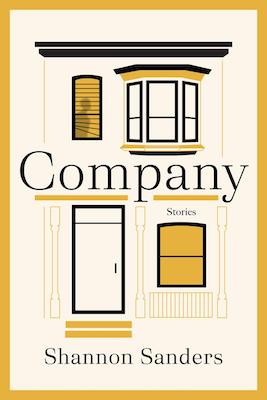Who is responsible for maintaining family lore? In Company, Shannon Sanders introduces—and repeatedly reintroduces—readers to the Collinses, a Black family with roots in D.C. and Atlantic City. Sanders, a master of character, makes every individual distinctive and recognizable even as they clearly belong to a whole, bound by shared history, values, and challenges.
In “The Good, Good Men,” two adult sons try, for better or worse, to fulfill their presumed filial duties; in “La Belle Hottentote,” four nieces fill in for an absentee daughter; and in “Company,” an aunt struggles to live up to family standards of hospitality. By presenting characters across different perspectives, at different ages, and under different circumstances, Sanders forces readers to reckon with them in their full, complicated, beautiful humanity. And though certain characters believe otherwise, we gradually discover that they’re all custodians of their lore, and of each other.
I spoke with Sanders over Zoom, where we discussed the many forms of inheritance, the importance of aunties, and the intense pressures of having—and being—a guest.
Emily Mirengoff: Many of the stories revolve around the Collins family, but not all of them. How did you determine whose stories you wanted to tell outside of the central cast?
Shannon Sanders: Three stories in the collection aren’t explicitly focused on Collins family members, though we do see all their protagonists, if briefly, in other stories. I wish I could say I always had a firm idea of how many stories would branch away from the family, but I didn’t. I wanted to show that some of the pressures facing the Collins family—microaggressions, respectability politics—are things that their broader community would also have to contend with. These aren’t just issues that are carried through the generations of a single family. They exist across the different communities depicted in the book: the Black community of D.C., Black people in academia, Black people in the professional workforce.
EM: You describe characters with such vivid, memorable efficiency. I think my favorite is when a man thinks of his mother as “a woman with air between her ears. Who lived by the word of her daily horoscope and always kept a tambourine handy to punctuate moments of spontaneous group laughter.” How do you come up with these kinds of details? Will your friends and family recognize themselves in your characters’ foibles?
SS: I could talk for hours about family and friends recognizing themselves in fiction! To begin with, none of these characters are real people. As a newer writer, I did start with prototypes of people I knew, people I felt conveyed certain elements of the human experience. For example—and he knows this!—the character of Theo is based on my brother in a specific phase of his life, when he’d recently moved to New York, and was trying to do a Mark Zuckerberg kind of thing.
Even now, as a more confident writer, real people still help provide details that create authenticity and verisimilitude, without corresponding one-to-one with characters. For example, my mom has a tambourine that she loves to play! But she is not that character; I just thought it made a great sensory detail. When characters do correspond more directly to real-life figures, I made them minor characters, who would just peek into the story.
When loved ones read our fiction, they’re looking for themselves, they’re sometimes nervous about how they’ll be portrayed, and they’re quick to recognize themselves where they are not. Writers are often eavesdroppers, people-watchers, and we’re collecting little bits of data to help form a cohesive person. The trick is to plagiarize the people in our lives without them realizing it. But I think it’s a compliment when people are sure that they recognize someone in a character, because that means that they’re seeing a person, as opposed to an assemblage of sentences.
EM: All these stories center around visitors—or company, per the title. We learn a lot about characters from how they prepare for, and receive, guests; the impressions they’re trying to make. What does company mean to you—and how does it overlap with family?
SS: This connective thread throughout the stories actually took me by surprise—someone else pointed it out to me. But I think it’s a literary obsession for me because it overlaps with the ideas of performance, code-switching, respectability politics, and self-presentation. There are so many decisions that go into how we self-present in different spaces, and that’s especially intense when we have guests, or are guests. When I was in my twenties, I did so much guesting and hosting for bridal showers, baby showers, weddings, and church events. Some of the most stressful moments of my life involved this expectation of putting myself on display, or doing my hosting job. I’m an introvert, so I had to pull on real reserves of strength to get through some of these interactions. On top of that, so much conflict comes not just from the event, but its preparations, all the freight attached to the event.
It overlaps deeply with family, because the way someone hosts doesn’t just implicate them, it implicates their upbringing, and I think mothers and grandmothers feel this especially acutely. I was most interested in how different generations of this one family would tackle these issues, particularly because of different generational expectations. Also, aunties are a huge motif in this book. The auntie is a figure in your life who knows what your upbringing looked like, who knows your freight and expectations, but her investment is different. She can bear witness to it, or nudge you in the ribs if your mom’s getting on your nerves. She can even be a maternal stand-in. She can see when your own preparation has failed, or when she thinks you’re absconding from it. I didn’t necessarily plan to set all the stories around these encounters, but they’re such momentous moments for women, and women of color, when we really take stock of who we are, what matters to us, and how we want the world to relate to us.
EM: Speaking of aunties, in the titular story, one of my favorite characters, Fay, complains about “curating the goddamned Collins family museum,” when her niece visits. At the same time, it’s clear that she also cherishes her role in keeping the family memory alive. How did you think about that ambivalence?
Writers are often eavesdroppers, people-watchers, and we’re collecting little bits of data to help form a cohesive person.
SS: It’s such a big responsibility—to feel like you’re the custodian of family history, and to feel responsible for passing it on to the next generation. But when people are challenged on it, they tend to cling to it. Within our families, we are empowered by our understanding of that history; everyone has their own lens on it, and sometimes those different understandings end up competing. In that story, Fay is riled up that her sisters have created a certain impression of their childhood, their parents, and their values to this new generation without consulting her. One of the most interesting aspects of the aunt figure is that she knows your parents in a way that you never will. But you, as the child, know your parent in a way that she never will, and sometimes those come into tension.
EM: The theme of inheritance appears on almost every page of this collection: inheriting money, looks, personality traits, lessons, talent, names, and memories. What do you think is the most important legacy that the Collins grandparents—these much-mythologized figures—leave their descendants?
SS: I agree—inheritance is a good way to sum up one of the major concerns of the book. I’ll also add, in addition to those positive inheritances: hang-ups, self-consciousness, and some real tensions! I think the grandparents’ major legacies are work ethic, concern with education and self-presentation, and self-reliance. What’s fun about writing multigenerational stories is that you build this family tree, and then you see how a legacy gets fractured and reinterpreted across generations. All four of their daughters have a strong work ethic, though how that looks in practice is a bit different for each one. They also engendered a real communal responsibility—asking the daughters to look out for each other, which we see play out in the next two generations.
And they passed along the ability to turn lemons into lemonade—to take a negative circumstance and bring out its most positive aspect. The grandparents owned a nightclub: they took a segregated Atlantic City and turned it into a fertile place to run a business. They took drunk patrons and turned them into friends, in many cases. It’s resilience, but a step beyond as well: the ability to not just survive, but thrive, in difficult circumstances. That’s a legacy that we see in all the youngest generation.
EM: In the stories “Birds of Paradise” and “La Belle Hottentote,” we see the same evening—the same events, the same sartorial choices—through two different sets of characters. Some impressions overlap, and many contradict each other. As a reader, you never get the impression that either narrator is lying or mistaken; they’re just experiencing different truths. As the author, how did you imbue both stories with equal credibility?
SS: That’s another reason I really wanted to write a multi-generational book. I didn’t want to tie the reader to a single protagonist. As millennials, I think we have a little bit of a superpower—and maybe this is a phase that every generation passes through—which is the ability to empathize with our parents, with our generation, and the slightly younger, next generation. As an observer of my mom and my many aunties, I’ve observed a lot of their concerns, the tensions between them and their children, their worries about the next generation’s values. I’ve also observed some of their misunderstandings about the pressures that we face. A basic example is the perpetual question, “When are you going to buy a house?” We’re like, “We would love to! Sell them to us at a price we can afford.” I have so much empathy for them because I’ve listened so closely to them throughout my life. But I also know that we, coming of age now, have a point too, in many cases. I wanted to really explore that intergenerational tension from both sides.
In the two stories about the party, there’s a character who has been built by a certain patriarchal workplace environment, who invested her life and career in it and fully bought into it. But I also wanted to show these young people, on the cusp of entering their own adulthood, reacting to that same environment. When we’re handed the mantle and told, “this is what you’ll have to do to survive a workplace,” many of us just took that mantle and said, “Okay, this doesn’t sound great, but I’ll give it a shot.” Others rejected it wholesale, and that’s why we see such progress in the ways that women and people of color are able to participate in those spaces. Within my own family, I have a corporate job, while my brother is a creator; he’s entirely rejected it. Intergenerational tension is not between one generation that knows what it’s talking about and one that doesn’t. It’s about two generations that both have completely reasonable understandings of the world based on how they were built, and then have to figure out how to deal with each other. All the terrible events of the last twenty years—they’re so much richer if we see them through the eyes of fully formed adults, who came of age in the ’70s, as well as later generations, who are still learning about the world as they experience it.

